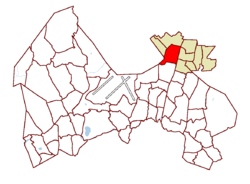
Vantaa is a city and municipality in the region of Uusimaa in Finland. Vantaa has a population of 245,384, making it the fourth most populous city in Finland. Vantaa is part of the Helsinki Metropolitan Area, which has over 1.5 million inhabitants. The administrative centre of Vantaa is located in the Tikkurila district. Vantaa lies in Southern Finland and shares borders with Helsinki, the Finnish capital, to the south, Espoo to the southwest, Nurmijärvi to the northwest, Kerava and Tuusula to the north, and Sipoo to the east. The city covers a total area of 240.35 square kilometres (92.80 sq mi)), of which 1.97 km2 (0.76 sq mi) is water.

Helsinki-Vantaa Airport, or simply Helsinki Airport, is the main international airport of the city of Helsinki, its surrounding metropolitan area, and the Uusimaa region in Finland. The airport is located in the neighbouring city of Vantaa, about 5 kilometres (3 mi) west of Tikkurila, the administrative centre of Vantaa and 9.2 NM north of Helsinki's city centre. The airport is operated by state-owned Finavia.
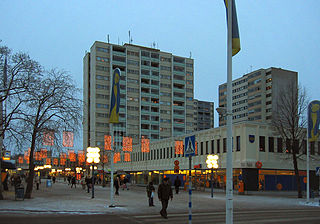
Kerava is a town and municipality within the Uusimaa region of Finland. The municipalities of Vantaa, Sipoo and Tuusula are adjacent to Kerava, which is part of the Helsinki metropolitan area.

Tuusula is a municipality of Finland. It belongs to the Helsinki sub-region of the Uusimaa region. The municipality has a population of 40,885 (19 September 2023) and is by far the third largest municipality in Finland after Nurmijärvi and Kirkkonummi that does not use the town or city title by itself.
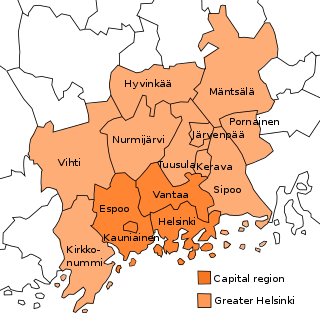
Greater Helsinki is the metropolitan area surrounding Helsinki, the capital city of Finland. It includes the smaller Capital Region urban area.

The Ring Rail Line is a railway route in the area of the city of Vantaa, in the Greater Helsinki Metropolitan Area of Finland. It connects Helsinki-Vantaa Airport and the adjacent Aviapolis business and retail district to the Helsinki commuter rail network. The line fills the gap between Vantaankoski and Tikkurila railway stations, travelling in tunnel underneath the airport.

Tikkurila is a district and major region of the municipality of Vantaa, Finland. Located in the eastern half of the Helsinki conurbation, some 16 kilometres (10 mi) north of the capital's downtown district, it is the administrative and commercial hub of Vantaa, although Myyrmäki is a rival commercial hub within the municipality.

Public transport in Helsinki consists of bus, tram, metro, local railway and ferry services. The system is managed by the Helsinki Regional Transport Authority and covers Helsinki, Espoo, Kauniainen, Vantaa and the outlying Kerava, Kirkkonummi, Sipoo and Tuusula.
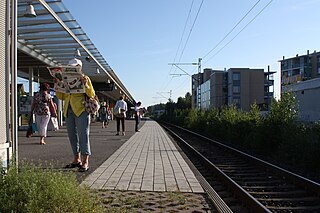
Korso railway station is a Helsinki commuter rail station located in the district of Korso in the city of Vantaa, Finland. It is located approximately 22 kilometres (14 mi) from Helsinki Central railway station. The station is located in the C zone of the HSL area.

Louhela railway station is a VR commuter rail station located in Vantaa, Finland. It is approximately thirteen kilometres north of Helsinki Central railway station.

Aviapolis is a business, retail, entertainment, and housing marketing brand area in central Vantaa, Finland, covering roughly 40 square kilometres (15 sq mi), including Finland's main airline hub and airport, Helsinki Airport.

The Helsinki Regional Transport Authority is the inter-municipal authority that maintains the public transportation network of the nine municipalities of Greater Helsinki, Finland.

Koivukylä is a district and major region of the municipality of Vantaa, Finland. The district hosts a multitude of services, such as several stores and a library. It has its own railway station, the Koivukylä railway station, which serves commuter trains around Greater Helsinki.

The Peijas Hospital is a hospital belonging to the Helsinki and Uusimaa hospital district (HUS), located in Asola, Vantaa. Since 2001 the hospital has been part of the functionality division of the Helsinki region university central hospital.

Esa Erkki Piironen is a Finnish architect. He studied architecture at Helsinki University of Technology, qualifying as an architect in 1970. He studied architecture and urban design in North Carolina State University in Raleigh, North Carolina, and was awarded the Master of Architecture in 1972. He was working as a teaching assistant at Helsinki University of Technology 1972–81, and was awarded Licentiate in Technology in 1978. Visiting professor at Guangdong University of Technology School of Art and Design starting from 2012.

Helsingin pitäjän kirkonkylä is a city district in Vantaa, Finland. It is located in central Vantaa, in the Tikkurila major region. It is bordered to the north by the Ring III beltway, the west by the Tuusulanväylä highway, and south and east by the Helsinki neighbourhood of Siltamäki. The Helsinki–Vantaa Airport is located 7 kilometres (4.3 mi) northwest of the district.
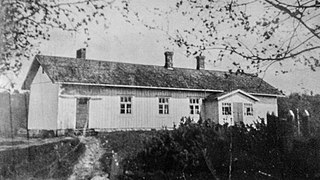
Fallbacka Farm was located in Tuusula (Finland) in the area where present-day Vantaa, Kerava and Tuusula meet, by the main railway of Finland, between the stations in Korso and Savio. The farm and the main building were inhabited by the farmer family Fallström. There is evidence at least dating back to the 18th century. The main building of the farm, which was at the highest point in the area, that hosted the first school in the area, was demolished in the 1960s. Nowadays, in the area are, for example. Rudolf Steiner School in Vantaa and private residences.

Helsingin Uutiset is a free newspaper that has been published in Helsinki, Finland since the early 2020 as six different local editions twice a week, on Wednesdays and weekends. The newspaper has a total of 350 thousand readers.

Dixi is a combined office, shopping and transport centre in Tikkurila, Vantaa, Finland, in connection to the Tikkurila railway station. Dixi is located to the west of the railway track, to the north of the old station building. The shopping centre was opened in 2015 and was expanded with a 100-metre-long (330 ft) expansion in 2017, with an upcoming final phase of a further 6,000 m2 (65,000 sq ft) of office space to its southern part on Ratatie.

Local and regional bus services are a large part of public transport in the Helsinki region. HSL bus services include internal services in Helsinki, Espoo, Kauniainen, Vantaa, Kerava, Kirkkonummi, Sipoo, Siuntio and Tuusula and regional services between them.

